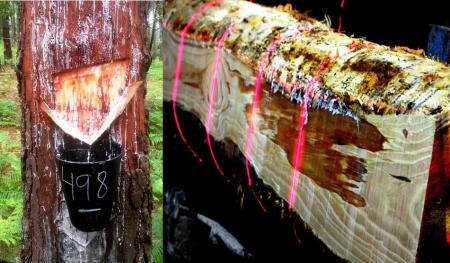
Objective:
Explore options in Pinus pinaster stand management with adapted methods to improve compatibility between resin and timber uses.
The aim is to verify whether the 20 cm wide resin tapping wounds, wider than the traditional 12 cm, can lead to an increase in the annual resin production per tree and if this tapping method is compatible with the traditional wood use in Galicia.
Context:
Studies of the wound tapping method with chemical stimulation, carried out in Galicia between 1950 and 1970, reported a mean resin yield of 2-3 kg per tree in Pinus pinaster Ait. Nowadays, the regional interest in resin production has been reactivated, and methods are being adapted to ensure the compatibility with the timber use.
Timber production is the main use in the NW of Spain. If a wider resin tapping wound would produce more resin than the traditional wound width, the use of resin in pine stands near the age of logging could be more easily integrated in the timber use management scheme.
Contacts:
Enrique Martínez Chamorro, enrique.martinez.chamorro@xunta.gal, https://lourizan.xunta.gal/
Further information:
https://scholar.google.es/citations?hl=es&user=ukTSrAYAAAAJ